Porcelain Insulator News
by Jack H. Tod
Reprinted from "INSULATORS - Crown Jewels of the Wire", November 1973, page 26
Preferably direct porcelain news items and questions directly to Jack H. Tod,
3497 N. 47th Place, Phoenix, Ariz. 85018. Please enclose reply stamp. All mail
will be answered, and the most newsworthy items and questions of general
interest will be published as space permits.
NEW PIN TYPE MARKING
Carl Lencse (E. Liverpool, Ohio) reports having found two specimens of U-98
mine insulators with the marking shown here at the old plant site of American
Porcelain Co. in East Liverpool. This not only adds another name to the list of
companies having made pin types, but it also adds still another "customer
marking" to our ever-growing list of these.
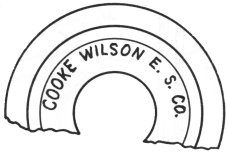
The American Porcelain Co. was established In 1914 in the old John W. Croxall
& Sons plant originally built in 1845 by Ball & Morris (Union' Pottery)
and owned by Croxall after 1857. American changed the product to electrical
porcelain and made all types of dry process insulators until operations were
suspended in 1932.

I have not been able to locate "Cooke Wilson" in any of my files or
industry directories, but I presume it might have been a jobber like Electrical
Service & Supplies Co.
Carl's specimens are dry process items, and the marking is embossed (raised
letters).
Dear Jack:
I enjoyed your article on cleats and nail knobs in the June issue of Crown
Jewels. When I dig them up, I don't throw them away any more.

I recently dug up the top part of a 3-wire cleat embossed H. P. CO. Could you
please tell we what company this is? Vance Rightmire, Austin, Texas
- - - - - - -
Dear Vance:
Nope. The initials don't fit any company in my files or directories.
Jack
Dear Mr. Tod:
In the June issue of Crown Jewels, page 30, in a drawing of a MACOMB that
appears very much like one I have. Is this the same insulator, and are they that
rare?
Harold Carlin
308 Indiana
Rapid City, S.D. 57701

- - - - - - - - -
Dear Harold:
No. I would class the Macomb transposition scarce at best. I probably have
seen only 5% of the better porcelain collections and go to about 5% of the
shows, but I've just counted on my fingers 12 collections in which I've seen
this item in the past 2 years, I have seen 2 for sale on show tables, and I have
heard of an old line with these on it (and which I hope to get to in the
future).
I have pictured above the six known major varieties of Macomb dry process pin
types, reading from the left: U-42 pony, U-57 exchange, U-197 transpo, U-239B
signal, U-244 distribution, and U-443 cable type.
Of these, the U-443 can be classed an rare. The U-42, U-197 and U-239B are
scarce (about equally). The U-244 in common, and the U-57 is very common. I have
seen the transposition sell at shows for $20, but I think it's a bit better than
that, maybe $30 or so, because it is a much more desirable shape than the pony
or signal which are equally scarce (and which sell for $4 to $6).
Keep in mind that no company tools up to make only a few of anything, and a
good pressman can easily form over 1,000 dry press pin types in one 8-hour
shift. Obsolete power types are cleaned from the lines and hauled to the dump,
but serviceable phone types keep getting used over and over, and many old phone
lines are just left in the hills to rot. In time, I'm sure the growing interest
in porcelains will cause these and many of the other TUF phone styles to crawl
out of the hills so they will not be on so many want lists.
There are at least 8 other very desirable porcelain transpositions which are
more scarce than the Macomb U-197, but some collectors continue to
"romance" Illinois' early MACOMB marking on dry press items.
Jack
Kim Sievert (Cupertine, Calif.) reports having found two more specimens of
U-579 with the "LOCKRE" error handstamp marking, plus one specimen
from the same source with the correct spelling. He sent us a very clear closeup,
photo of the very neatly applied marking, and there's no doubt about it. Locke
specialists should be on the lookout for these, as any errors in porcelain
handstamp markings are very unusual.

At the right in a photo of two metal handstamp logos I have and which were
used at the P.P. Inc. plant years ago. The one at the left was for marking the
PP pin types, and the other was for Line Material Co. contract items.
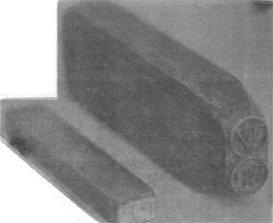
As you can see, it would be illogical for a porcelain company to accept and
pay for such an expensive marking device if the maker made such a gross error as
misspelling the name of the porcelain manufacturer! Including the LOCRE error
above, I know of only three metal handstamp errors and no errors on rubber
handstamps for underglaze markings.
Dear Jack:
Enclosed are photos ... of an object that could be an insulator. It is made of
white porcelain and brass.
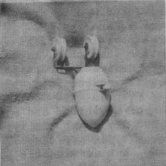
Can you identify it & do you have any idea of its value? I would
appreciate any information you could come up with. Dean Axelson
Willowdale,
Ontario
Canada
- - - - - - - -
Dear Dean:
No, I cannot identify it and if it were an Insulator, I wouldn't have the
foggiest notion of value. If I got two free guesses, I'd say it's either part of
a Smoky Mountain still or something that fell out of orbit the last time Skylab
went over.
Jack

NEW INSULATOR MANUFACTURER
Add the Gladding Ceramic Insulator Co. to the list of companies having
manufactured pin type porcelains. This marking was first reported in the
February 1973 issue of Crown Jewels, page 16. Larry Thomas (Oroville, Cal.) was
the one who gave me leads which, after a number of letters and long distance
calls, helped me obtain information on the company.

This company is located in San Jose, California. They manufacture wet process
styles U-735A and Sim U-762 pin types, plus some guy strains and rack spools.
Nearly all sales are to Pacific Gas & Electric Co., but the company is in
the process now of developing a sales organization to expand their operation.
All the million plus units made thus far have been sky glaze, black radio
treated tops and with the underglaze marking shown above. An initial shipment
was made with an incuse marking, but this was changed to the underglaze one
above and which is still being used.
The origin of the company stems from Gladding, McBean (Lincoln, Cal.) which
was founded in 1875. The Gladding family split off from that company in 1924 and
founded the present company for the manufacture of tile products.
Westinghouse had operated a plant at Emeryville, Cal. from 1923 to 1944, and
it later regretted having closed this plant just prior to the postwar expansion
boom. As the result of talks with P G & E and some firm order commitments,
Gladding started installing equipment for wet process insulator manufacture in
1963, and the first shipment of insulators was made in Sept 1964. This is the
only pin type manufacturer west of the Ohio area.
Insulators with the GLADCO marking are currently available only in western
areas, but if collectors are patient, specimens will become generally available
in time.
 |
NEW MARKING |
 |
The General Porcelain Co. incuse marking at the left above in the common G.
P. Co. marking all collectors are familiar with. The smaller incuse marking (no
periods) at the right above is a new one I have recently discovered on a white
U-474. I have inspected many hundreds of G. P. Co. pin types of more than a
dozen styles and have never before seen this handstamp logotype, so it must be
scarce.
Many of the smaller porcelain companies have made ware other than insulators
either before or after they made insulators, and I have come upon many unusual
things while pawing around the old dumps of over 50 defunct porcelain companies
in the past several years.
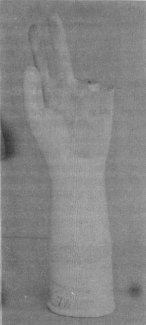
At the old site of the Colonial Insulator Co. plant in Akron, there was a
tremendous sprinkling of fingers and thumbs over a square block area. I finally
found this piece which partially escaped the bulldozers, and it is obvious these
were dipping forms made for a rubber glove manufacturer. Note size 7-1/2.
I'm a bit fond of it because it is marked "THE COLONIAL INSULATOR
CO.". It is dated Aug 1, 1959 and is marked "PATENT 2261583".
Another oddity is the very contradictory past/future tense marking
"PAT'D PEND." !
This interesting item will continue to sit on my shelf with the insulators
unless I drop it some day and break off the index finger.
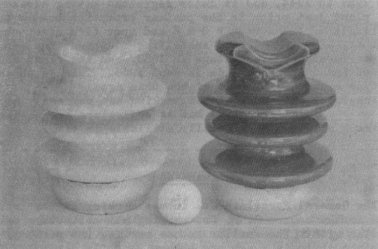
Here's something special for someone who has everything else, and it's a
shame the photo isn't in color! The line post at the left is a bright canary
yellow, and the one on the right in a pretty cobalt blue. You won't ever see one
of these looking up at the crossarms; you have to look down. A. B. Chance Co.
made these a number of years ago for golf tee markers! They are identical with
production run items and fully tested. Only those pretty colors set them apart.
NOTICE: By the time you receive this issue of Crown Jewels, Supplement B to
"Porcelain Insulators Guide Book for Collectors" should be off the
press. It does not duplicate any of the material in the book or in the 1972
supplement but contains all new information on porcelain pin types learned in
the past year - over 100 new U-number shapes, 15 new pin type markings, more
history on companies, many price revisions, etc.
The sale proceeds do not cover the out-of-pocket cash cost in composing,
printing and mailing these supplements to keep the book up to date, and you can
help to reduce this financial negative by ordering now before reminder mailings
are made. Price is $1.95 ppd from me at 3427 N. 47th Place, Phoenix, AZ 85018.
Add 25 cents for airmail instead of 3rd Class mail.
Jack H. Tod
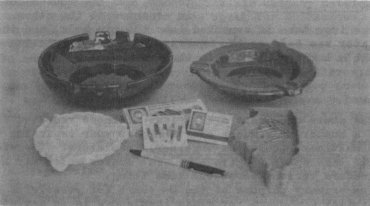
Pictured above are more porcelain insulator company "advertisers"
(from my collection), and this is only a sample of what you can get if you
collect these.
The three ashtrays reading clockwise from the white one, all marked with the
company name and/or trademark, are: Pass & Seymour, Inc.; Illinois Electric
Porcelain; and I-T-E, Victor Insulators Division. The book matches are Illinois
Elec. Porcelain. The Illinois-shaped pin tray is, of course, Illinois also and
has a star and the tradename MACOMB at the location of Macomb. The ball pen is
from New Haven Porcelain Co., New Haven, W. Va.
Dear Mr. Tod:
Enclosed are sketches of two porcelain Insulators. One (shown at right) in
14" wide at top, 12-1/2" tall and weighs 38 pounds . The other In
13-1/4" by 11" and weighs 32 pounds.
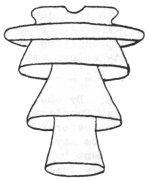
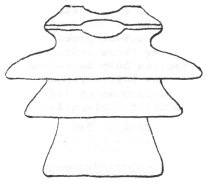
Any information you may have on these will be greatly appreciated - price -
age - company. I haven't been able to find anything on them in any of the books.
William Bramlett
St. Petersburg, Fla.
- - - - - - -
Dear Mr. Tod:
Enclosed is a drawing of an insulator I don't find in your book, and could
you give some information on it?
It is brown glaze and has no marking. The top skirt is 7- 1/2" diameter
and overall height in 6-1/4". The top two shells are glazewelded together,
and the bottom shell in cemented to the other. A large iron base is cemented
into the pin hole, and the insulator was held to the crossarm by a U-bolt
running through a horizontal hole in the iron base.
Leslie D. Ellicott
Clifton, Colorado
- - - - - - - -
Answers:
The above questions are typical of those received from quite a number of
readers over the past year regarding the large multipart (cemented together)
insulators. Therefore we will take space to give a general answer which may help
all readers curious about the same thing.
The primary purpose of the U- chart for porcelains and the similar CD- chart
for glass insulators in to assist collectors in cataloging their item, and mail
trading without these helpful charts would be very difficult.
Mr. Woodward's CD- chart for glass insulators contains all the glass pin type
shapes, including cemented- together multipart ones. However, the CD- chart has
only 200+ shapes to cover all the glass styles.
The U- chart for porcelain pin type insulators contains only unipart styles
(fired in one piece and not having parts cemented together). Even at that, we
already have over 900 different porcelain pin type shapes in 68 pages of
published style chart, and the figure may reach 1,000 shapes before it's over.
Whereas all collectors save unipart pin types and use the U- numbers for
cataloging and mail trading them, I know of no collector who is attempting to
make a general collection of the multipart styles. He would have to own his own
railroad train to mail trade them and an unused astrodome to house his
collection.
There has been a never-ending stream of different multis made by over a dozen
large porcelain companies in the past 75 years, and I would guess there would be
over 1,000 major different designs. It would take a room of draftsmen all year
just to draw them up even if someone was interested in researching them all, and
you couldn't lift a book with a style chart listing them all.
True, most collectors do save a few select multiparts if they are old, pretty
and small. And you might even want one of the very large ones around if you need
a sturdy stepladder, footstool or a birdbath for the back yard. If you must
describe these by mail to other collectors, just do the best you can with simple
sketches and overall dimensions, etc. The arbitrary decision to exclude all the
multis from the style chart could not be avoided, and this does mean we had to
omit some nice (and small) early ones which are desirable to collect. By
definition, "uniparts" are those "fired in one piece", and
this does allow us to include all the early glazeweld insulators in the U-
chart.
To answer the question about attribution of these, I have never attempted to
amass porcelain company catalog data on multis. The marked ones speak for
themselves, but it is an endless chore to scan all my old catalogs in an effort
to attribute all the unmarked ones.
To answer the questions about collector value of the multipart item in very
general terms. The smaller old classics have fair to very good value The larger
more modern types have very small to essentially zero value.
The small old types are desirable items and are usually collected right along
with the old unipart styles. Value them in the same manner, according to their
unusual design, their antiquity, pretty color and rarity of marking. A very
average value for these oldies runs $5 to $10 for the less intriguing ones and
up to $20 or more for the goodies.
More modern multis are a different proposition. Even the prettier and smaller
ones sometimes go begging at the $3 to $5 level. The bigger they get, the worse
the value. After you haul one of those big 13-inchers to a few shows and can't
trade or sell it at prices progressively lowering to $3 or less, you end up
trying to give it away (to someone you don't like maybe?). If that doesn't work,
you just leave it on the table at the end of the next show and let the cleanup
janitor worry about getting rid of it.
Cemented-in pins with or without flange bases and also "stuck" pins
tend to greatly diminish the value of these items - even the old ones.
Similarly, switch and bus types with permanently affixed iron caps and bases
don't usually make the team either.
Jack
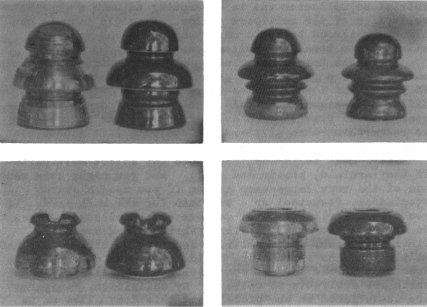
Those who collect both glass and porcelain insulators are sometimes partial
to styles coming both ways. Here are pictures of some of these. More in coming
months. The one on the left above in each photo is the glass one, and all the
photos are not to the same scale.
Top left. Glass CD-190/191, "TWO PIECE TRANSPOSITION", Brookfield No. 50,
aqua. Porcelain U-225A/B, Locke and Pittsburg (no name), dark brown.
Top right. Glass CD-202, "LOCKE VICTOR NY / No 14", Brookfield No.
51, green. Porcelain U-202A, Pittsburg No. 18 (no name), brown.
Bottom left. Glass CD-226, Brookfield No. 115 (no name) aqua. Porcelain
U-610, Locke No. 12 (no name), brown.
Bottom right. Glass "HEMINGRAY - 109" shackle insulator aqua.
Porcelain "COOK" No. 162 shackle insulator, brown.
Collecting currency and home printing are both honorable hobbies, but it is
prudent not to mix one with the other. Similarly, collecting porcelain
insulators and making ceramic arts are both fine hobbies, but you will be
creating problems for yourself if you try to marry the two.
The Code of Ethics being drafted by the National Insulator Association takes
a very strong position against home brewed and altered insulators. This will not
be tolerated of NIA members, and the items will not be allowed at any NIA shows.
Don't say we didn't tell you!
| 